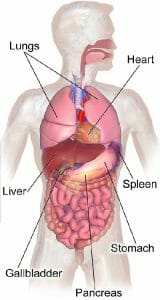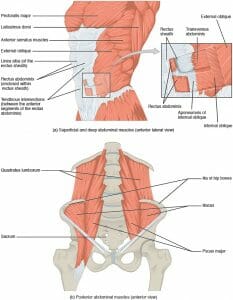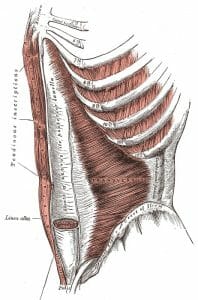Abdomen Definition
The abdomen refers to the region between the pelvis (pelvic brim) and the thorax (thoracic diaphragm) in vertebrates, including humans. The space constituting the abdomen is termed the abdominal cavity. The borders of the abdominal cavity are comprised of the posterior peritoneal surface, the anterior abdominal wall, the inferior pelvic inlet, and the superior thoracic diaphragm. The abdomen functions to house the digestive system and provides muscles essential for posture, balance, and breathing.
Abdomen Anatomy
The abdomen is comprised primarily of the digestive tract and other accessory organs which assist in digestion, the urinary system, spleen, and the abdominal muscles (shown below). The majority of these organs are encased in a protective membrane termed the peritoneum. While the digestive organs and assessor organs are located within the peritoneum, the kidneys, ureters and urinary bladder are located outsider of the peritoneum, and thus, are considered by some scientists to be pelvic organs.
Digestive Tract
The organs of the digestive tract consist of the small and large intestines, the stomach, cecum, and the appendix. The stomach is located between the esophagus and the small intestine in the upper left region of the abdomen. The stomach is responsible for the secretion of digestive enzymes and gastric acid required to digest food products. The small intestine is situated between the stomach and large intestine and consists of the three segments (duodenum, jejunum, and ileum), each exhibiting distinct functional properties. The duodenum is situated around the top of the pancreas and receives the digested stomach contents known as gastric chyme. The duodenum functions to neutralize the acid contained in the gastric chyme, as well as break down proteins and fat via enzymes and bile. The jejunum is the middle segment of the small intestine and is responsible for the absorption of sugar, amino acids, and fatty acids into the bloodstream. The final segment of the small intestine is the ileum, which connects to the large intestine. The ileum is responsible for the absorption of vitamin B12, as well as any remaining nutrients. The large intestine consists of the cecum, colon, rectum, and anus and stretches the entire width of the abdominal cavity. The primary function of the large intestine is to absorb water and store the remaining food material as feces until it can be excreted from the body via defecation.
Accessory Digestive Organs
The organs which assist in digestion consist of the pancreas, liver, and gallbladder. These organs secrete various hormones (i.e., insulin), enzymes, and bile via specialized ducts to aid in digestion. In particular, the pancreas functions as an endocrine organ which secretes a variety of digestive enzymes as well as hormones which aid in the digestion of food passing through the digestive tract. The pancreas is located behind the stomach. The liver is located in the upper right quadrant of the abdomen and functions to produce bile, which is responsible for breaking down fats. The liver also functions to produce hormones, regulate the storage of glycogen, and detoxification of the blood. The gallbladder is responsible for the storage of bile produced by the liver until it is released into the small intestine. The gallbladder is situated in the abdomen just under the right lobe of the liver.
Spleen
The spleen functions as a secondary lymphoid organ and is responsible for the removal of red blood cells via active filtration. The spleen also acts as a reservoir of red blood cells and metabolizes hemoglobin obtained from old red blood cells. The spleen is located in the upper left quadrant of the abdomen.
Urinary System
The urinary system consists of the kidneys, ureters, and urinary bladder, which are responsible for the filtration and excretion of waste in the form of urine from the body. Since these organs are located outside of the peritoneum, they can also be considered pelvic organs by some researchers. In particular, the kidneys function to filter the blood of waste products, regulate blood pressure, and control the blood pH. The ureters are connected to the kidneys and are used to drain urine into the urinary bladder. The urinary bladder serves as to store the accumulated urine until it can be excreted via urination.
Abdomen Function
The primary functions of the abdomen consist of digestion, breathing, posture and balance, as well as movement. The major organs located in the abdomen are associated with digestion, for which the functions are described above. The abdomen is also required for breathing via the accessory muscles of respiration. Such muscles are also involved in postural support, movement, balance, coughing, urination, vomiting, singing, childbirth, and defecation.
Respiration
Although the diaphragm controls respiration under steady-state conditions, the accessory muscles of respiration assist in respiration when greater effort is required. These muscles include the scalene and sternocleidomastoid muscles which serve to raise the ribcage. When these muscles are engaged, it is typically a sign of respiratory distress, such as that observed during an asthma attack.
Movement and Posture
Abdominal muscles are also required for the maintenance of posture and balance, as well as movement. The transverse abdominis muscle and internal obliques affect posture by providing spinal support during rotation and lateral flexion, and stabilize the spine when standing. Both of these muscles are situated deep within the abdomen. The external obliques also function to support the lateral flexion and stabilize the spine when standing. Finally, the rectus abdominis functions to bend the spine forward.
Abdominal Muscles
The abdominal muscles consist of three distinct layers residing within the abdominal wall and extend to the pubis, iliac crest, lower ribs, and vertebral column. The muscle fibers merge at the midline, surround the rectus abdominus, and join on the other side at a point known as the linea alba. The abdominal muscle fibers criss-cross each other for added strength, with the transverse abdominal muscle extending horizontally forward, and the internal and external obliques running upward and downward, respectively towards the front (shown below).
Rectus Abdominis
The muscles comprising the rectus abdominis are long and flat, with three tendinous intersections crossing over the muscle. As described above, the three muscles forming the lateral abdominal wall enclose the rectus abdominis in a sheath. The rectus abdominal muscles begin at the pubis bone, line the sides of the linea alba and attach to the lower ribs. The inguinal canal passes through the lower layers of the rectus abdominis muscles in the groin accommodate the attachment of the uterus in females and the dissention of the testes from the abdominal wall in males.
Transverse Abdominal Muscle
The transverse abdominal muscle is a flat, triangular muscle composed of horizontal fibers that is situated between the internal oblique and transverse fascia. The transverse abdominal muscle attaches at the inner lip of the ilium, the lumbar fascia, and the inner surface of cartilage on the six lower ribs. The transverse abdominal muscle passes behind the rectus abdominis to meet the linea alba.
Pyramidalis Muscle
The pyramidalis muscle is a small, triangular-shaped muscle situated in front of the rectus abdominis in the lower portion of the abdomen. The pyramidalis muscle stretches from the pubic bone to the linea alba, joining before the umbilicus. The pyramidalis muscle functions to contract the linea alba (shown below).
Quiz
1. Which of the following statements is NOT true regarding the pancreas?
A. The pancreas is situated behind the stomach.
B. The pancreas secretes insulin.
C. The pancreas is an endocrine gland.
D. The pancreas is a secondary lymphoid organ.
2. A primary function of the spleen is:
A. Regulation of blood pressure.
B. The production of digestive enzymes.
C. Secondary lymphoid organ.
D. All of the above are primary functions of the spleen.
3. The major muscles providing spinal support required for posture in humans are:
A. Rectus abdominus
B. Transverse abdominus
C. Linea alba
D. Pyramidalis
4. Which of the following abdominal organs is NOT required for digestion?
A. Liver
B. Gallbladder
C. Spleen
D. Pancreas
References
- Bilal M, Voin V, Topale N, Iwanaga J, Loukas M, and Tubbs RS. (2017). The Clinical anatomy of the physical examination of the abdomen: A comprehensive review. Clin Anat. 30(3):352-356.
- Ghamkhar L and Kahlaee AH. (2015). Trunk muscles activation pattern during walking in subjects with and without chronic low back pain: a systematic review. PM R. 7(5):519-26.
- Stensby JD, Baker JC, and Fox MG. (2016). Athletic injuries of the lateral abdominal wall: review of anatomy and MR imaging appearance. Skeletal Radiol. 45(2):155-62.
Abdomen



No comments:
Post a Comment